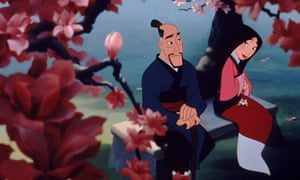But when in 2014
80% of films had no women credited as writers, perhaps it’s to be expected that women overall had fewer lines and that the on-screen women the mostly male writers and directors thought audiences would like to hear are the youngest.
Maybe it’s even just par for the course that a summer would-be blockbuster such as Men in Black 3 had just one woman with enough lines to show up in the Polygraph study: “Hot Pants Girl”. (Then again, even testosterone action fest Expendables 3 gave its sole female speaker an on-screen name, even if she didn’t have that much dialogue.)
Still, when the dragon in
Mulan has more dialogue than the titular character, when films with casting gender parity feature men speaking more often than women, and when only 18% of films have women as two of the top three speaking parts (a scenario that male actors go into 82% of the time), the question isn’t just whether women are underrepresented in Hollywood.
The question is who gets to give voice to the stories that form our shared cultural narrative, and the answer is “men”.
And yet, when we go to the movies, women are rarely the leads unless it’s a “women’s” movie – and sometimes, even when it is, we still aren’t the ones doing most of the talking.
Research from the University of Southern California’s Annenberg School for Communication and Journalism
shows that for every one woman who speaks even in films with less than an R rating, there are around three male speaking characters and that crowd shots have an average of 17% women (a ratio that hasn’t changed since 1946).
It’s nonetheless rare – unless you
count Geena Davis – that anyone comments on the lack of women on screen and speaking. Studies such as the Annenberg one show that we view a lack of female representation as normal, and we view actual demonstrable parity as giving unequal weight to women.
The lack of female representation isn’t intentional or even probably conscious: it’s just that when women aren’t seen and aren’t heard in public and cultural spaces, we come to view that absence as normal. We come to see the “everyman” as, well, a man: we learn to identify with men, to see ourselves in men (even as women) and to see the woman’s perspective as the minority one, even if we are a slight demographic majority.
Movies starring, featuring and weighted male are just movies; movies starring, featuring and weighted female are “chick flicks”, and ones that supposedly only women want to see.
That the data on “chick flicks” and female moviegoers doesn’t support the false hypothesis that women aren’t enough of an audience to matter to Hollywood hasn’t done nearly enough to spur change in the industry or our society. Just witness all
the griping about Rey’s ascendence in Star Wars: The Force Awakens. Some male fans seemingly couldn’t see themselves in an orphan stranded on a desert planet who has access to The Force and helps defeat the Empire in battle unless that orphan was male like Luke Skywalker or Finn, John Boyega’s character, and complained that the movie had gone too far by casting a woman in the lead. But 78% of the dialogue was spoken by men and Finn had more lines than Rey, even though The Force Awakens had the highest percentage of dialogue spoken by women (28%): in the original movie, Episode IV, just 6% of the dialogue was spoken by women.


















